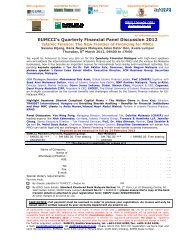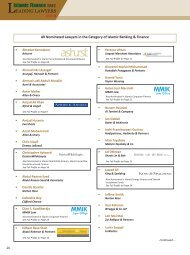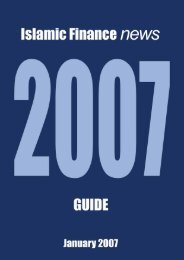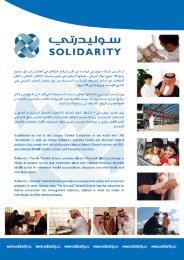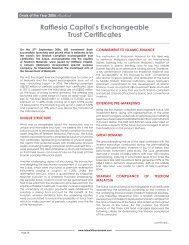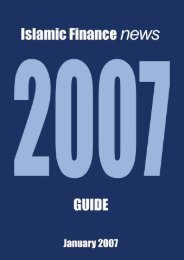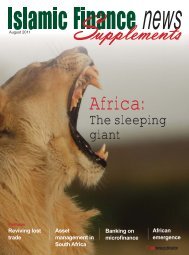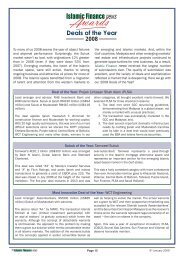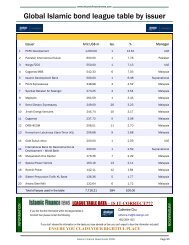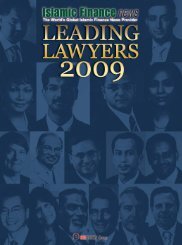Create successful ePaper yourself
Turn your PDF publications into a flip-book with our unique Google optimized e-Paper software.
www.islamicfi nancenews.com<br />
<strong>Islamic</strong> <strong>Finance</strong> news Guide 2008<br />
2007 Global Takaful Review: Evolving Trends,<br />
Opportunities and Challenges<br />
By Sohail Jaffer<br />
The renaissance in socially responsible investing<br />
and demand for Shariah compliant solutions<br />
has spurred the double-digit growth of the global<br />
demand for Takaful, or insurance based on<br />
principles of mutual assistance. The fi rst Takaful<br />
company was established in 1979. Now, there are<br />
over 250 globally.<br />
According to the Standard & Poor’s April 2007 report on<br />
Takaful, “the GCC Takaful market is currently growing at<br />
40% per year and the opportunities for increased uptake of<br />
Takaful in the GCC markets are positive. The GCC insurance<br />
market has a potential size of US$20 billion (currently US$6<br />
billion). Within the GCC insurance sector, the Takaful market<br />
has the potential to reach US$4 billion at the current level of<br />
development (currently US$170 million)”.<br />
Based on a 2007 Oliver Wyman report, “in terms of headline<br />
revenue potential, reasonable assumptions about likely<br />
penetration among Muslims, and adjustments for non-Muslim<br />
potential, suggest that there is worldwide Takaful premium<br />
potential of at least US$20 billion annually, compared to<br />
today’s fi gures of US$4 billion at most”. Wyman’s analysis<br />
suggests that up to 20% of Takaful revenues could emanate<br />
from non-Muslim customers.<br />
More recent analysis published by Fitch Ratings put the<br />
total global Takaful contributions at US$2.6 billion in 2006,<br />
which the agency described as “very small compared with the<br />
world’s insurance sector as a whole”. However, Fitch added<br />
that Takaful’s “infl uence and importance extend well beyond<br />
its current size, and there is substantial potential for growth<br />
both in Muslim communities in the Middle East and Asia as<br />
well as in more mature OECD (Organisation for Economic<br />
Cooperation and Development) markets like the UK, France<br />
and Germany, which have signifi cant Muslim minorities”.<br />
The nascent Takaful industry needs to gain critical mass, to<br />
provide an innovative array of products and superior quality<br />
customer services, to build worldwide brand recognition and<br />
to exceed performance standards set by the conventional<br />
insurance industry.<br />
Product innovation and distribution<br />
The Takaful product family spans general, life, health and<br />
pensions business. The two main business models used in the<br />
Takaful industry are Mudarabah and Wakalah. The Wakalah<br />
model is more prevalent. Under this model, the Takaful operator<br />
acts as an agent (Wakeel) for the participants and manages<br />
the Takaful/reTakaful fund in return for a defi ned fee.<br />
“Acceptance of Shariah compliant<br />
savings, education, marriage<br />
and retirement plans is gradually<br />
increasing among the affl uent”<br />
Due to the ethical guidelines underpinning Shariah compliant<br />
fi nancial services, the increasing transparency of customer<br />
terms and conditions, pricing structure, regular compliance<br />
monitoring by the relevant Shariah boards and supervisory<br />
regulators and adequate disclosure of information and<br />
transparency to policyholders, such offerings have tended to<br />
attract both Muslim and non-Muslim customers.<br />
Acceptance of Shariah compliant savings, education,<br />
marriage and retirement plans is gradually increasing among<br />
the affl uent, but signifi cant investment in customer education<br />
and training of fi nancial planners and investment advisers<br />
is still necessary. A successful distribution model needs to<br />
develop a thorough understanding of the customer’s needs,<br />
offer product and process innovation, eliminate fl aws in<br />
product terms and cost structures, and enhance customer<br />
service delivery.<br />
Advent of bancassurance<br />
In light of the exponential growth of <strong>Islamic</strong> retail banking and<br />
fi nance, several enterprising banks have sought to diversify<br />
their business by including bancassurance in their product<br />
offerings. Hence, <strong>Islamic</strong> savings, education, marriage and<br />
retirement plans that combine investments with protection<br />
benefi ts are starting to become attractive. The average<br />
maturity of such capital accumulation plans is between 15<br />
and 20 years and the customer retention period in performing<br />
programs is much longer than direct investments in mutual<br />
funds.<br />
Product customization for the different bank channels (retail,<br />
mass affl uent, private banking), customer referrals and gaining<br />
brand loyalty are critical success factors. Banks are keen to<br />
work with strategic product partners who offer bespoke family<br />
Takaful investment-linked plans, the opportunity to “white<br />
label” such a plan and have open investment architecture.<br />
<strong>continued</strong>...<br />
Page 63



